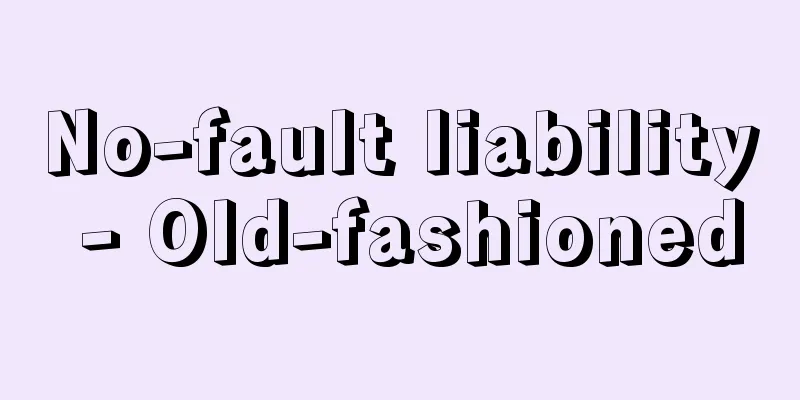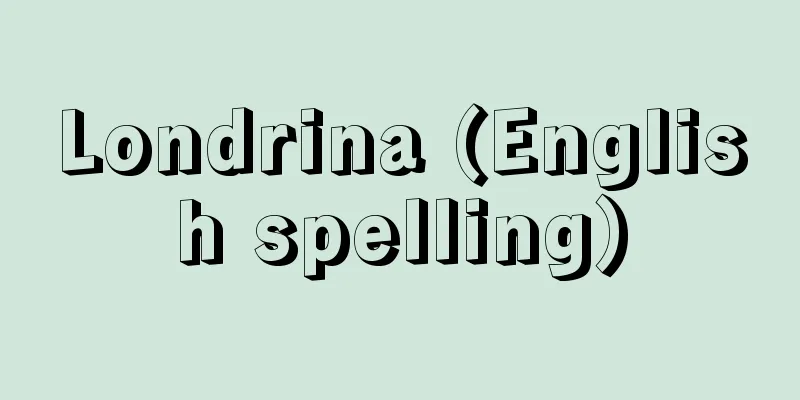No-fault liability - Old-fashioned

Under civil lawWhen a person causes damage to another person, even if that person is not negligent, he/she is liable for civil liability (especially tort liability). This is called strict liability and is contrasted with negligence liability. Modern law, based on the principle of capitalist liberalism, is based on the principle of strict liability. Article 709 of the Japanese Civil Code is an example, and provisions of strict liability are exceptional (such as the owner's liability in Article 717 of the Civil Code). However, the development of modern industry has created many dangers (high-speed transportation, electricity businesses, oil refineries, etc.) and companies that make huge profits while spreading such dangers, making the implementation of the principle of strict liability inappropriate. This is because those who create dangers should be liable for compensation for the damages that result from them (risk liability principle), and if they cause damage to others in the process of making profits, it is fair to require them to compensate from those profits (reward liability principle). Therefore, strict liability has been adopted in various special laws. Examples include the Mining Act (Article 109) and the Act on Compensation for Nuclear Damage (Article 3), and no-fault liability has also been introduced for pollution. [Takahisa Awaji] No-fault liability for mining pollutionThe history of mining damage resulting from mining operations is long, and the provisions of no-fault liability were incorporated into the old Mining Act of 1939 (Showa 14), which was inherited by the current Mining Act enacted in 1950 (Showa 25) after the Second World War. According to this act, when damage is caused to others by excavating land for mining minerals, discharging mine water or wastewater, piling up waste rock or slag, or discharging mine smoke, the holder of mining rights in the mining area (the holder of mining rights if a mining lease area is established) must be liable for damages even if there is no negligence, and if the mining rights have already expired when the damage occurs, the holder of mining rights at the time of the expiration of the mining rights is liable (Article 109, Paragraph 1). If the mining rights are transferred (or the mining lease is established) after the damage occurs, the holder of mining rights at the time the damage occurred and the holder of mining rights (or the holder of mining rights) thereafter are jointly liable for damages (Article 109, Paragraph 3). Examples of the application of these provisions include the Itai-itai disease lawsuit judgment and the Toroku arsenic pollution lawsuit judgment. In 1972, the Air Pollution Control Act and the Water Pollution Control Act were amended to apply strict liability to air pollution and water pollution. In other words, according to the Air Pollution Control Act, if a person's life or body is harmed by a substance that is harmful to health caused by business activities at a factory or workplace, the business operator must compensate for the damage even if there is no negligence (Article 25, Paragraph 1), and according to the Water Pollution Control Act, if a person's life or body is harmed by the discharge of a harmful substance contained in wastewater or wastewater caused by business activities at a factory or workplace, the business operator must be liable for damage even if there is no negligence (Article 19, Paragraph 1). In addition, when the occurrence of damage is caused by a natural disaster or other force majeure, the court may take this into consideration when determining the liability and amount of compensation (Article 25, Paragraph 3 of the Air Pollution Control Act and Article 20, Paragraph 2 of the Water Pollution Control Act). [Takahisa Awaji] Nuclear no-fault liability for damagesIn preparation for damage caused by the use of nuclear fuel (such as the operation of a nuclear reactor), the Law on Compensation for Nuclear Damage was enacted in 1961, which stipulates the no-fault liability of nuclear operators. According to this law, when nuclear damage occurs as a result of the operation, processing, or reprocessing of a nuclear reactor, or the use of nuclear fuel material, the nuclear operator involved in the operation of the reactor, etc., must be liable for damages regardless of whether or not there was negligence (Article 3, Paragraph 1, Main Text). However, no-fault liability does not apply when the damage is caused by an abnormally large natural disaster (such as an abnormally large earthquake) or social upheaval (such as war or civil unrest) (Proviso of the same Article). [Takahisa Awaji] Liability for non-fault damages in violation of the Antimonopoly ActThe Antimonopoly Act prohibits private monopolies, unreasonable trade restrictions, and unfair trade practices in order to ensure fair and free competition, but if a business operator violates these prohibitions and causes damage to other businesses or general consumers, the business operator must be liable for damages even if he or she is not negligent (Article 25, Paragraphs 1 and 2). Furthermore, this right to claim damages cannot be asserted in court until the decision of the Fair Trade Commission has become final (Article 26). [Takahisa Awaji] Liability close to strict liabilityAmong the legal provisions governing liability for damages, there are some that shift the burden of proving negligence (for example, Civil Code Articles 714, 715, 717, and 718, and Automobile Liability Security Act Article 3). In such cases, if proof of exemption from liability (such as proof that there was no negligence) is difficult to establish, the situation will effectively become similar to no-fault liability. [Takahisa Awaji] Under international lawUnlike ordinary international liability, absolute liability is the liability under international law that is pursued to remedy the infringement of international legal interests or to prevent danger, even if there is no international illegal act or intention or negligence. In particular, with the recent practical application of science and technology, the principle of risk liability is adopted, such as by prescribing no-fault and strict liability by special treaties and limiting the grounds for exemption from liability for third-party damages due to accidents in certain business fields that incorporate high risks. Among them, there are those that stipulate the limited liability of the business operator and the obligation to establish insurance corresponding to it, and specify the domestic court with jurisdiction (civil liability), such as damages caused by aircraft crashes and marine pollution, those that stipulate the shared liability of the country that permitted the business for the portion of civil liability that exceeds the operator's ability to bear, such as nuclear accident damages (mixed liability), and those that concentrate no-fault and unlimited liability for damages, such as damages caused by falling space objects, on the country that permitted and supervised the activity (exclusive liability of the country). However, there are certain areas in which strict liability is recognized, and the United Nations International Law Commission is working to generalize such "international liability for harm caused by acts not prohibited under international law," but has not yet reached an agreement. [Yamamoto Soji] "Masao Ishimoto, 'No-Fault Liability for Damages', 2 volumes (1983, Horitsu Bunkasha) " "Santarou Okamatsu, 'No-Fault Liability for Damages' (1953, Yuhikaku)" " Soji Yamamoto, 'Risk Liability in International Law' (1982, University of Tokyo Press)" [Reference item] |Source: Shogakukan Encyclopedia Nipponica About Encyclopedia Nipponica Information | Legend |
民法上ある者が他人に損害を生ぜしめた場合に、その者に過失がなくても民事責任(とくに不法行為責任)を負う場合に、これを無過失責任といい、過失責任に対置される。近代法は、資本主義的自由主義のたてまえから過失責任主義を原則とする。日本の民法第709条はその例であり、無過失責任の規定は例外的である(民法717条の所有者の責任など)。しかし、近代産業の発展は、多くの危険(高速度交通機関、電気事業、石油コンビナートなど)と、そのような危険をまき散らしながら膨大な利潤を得る企業を生み出し、過失責任主義の貫徹を不適当なものとした。なぜなら、危険をつくりだした者は、それから生じた損害について賠償責任を負うべきであるし(危険責任主義)、利益をあげる過程で他人に損害を与えたならば、その利益のなかから賠償させる(報償責任主義)のが公平にかなうからである。そこで、種々の特別法で無過失責任が取り入れられるに至っている。鉱業法(109条)、「原子力損害の賠償に関する法律」(3条)などはその例であり、公害についても無過失責任が導入された。 [淡路剛久] 鉱公害無過失責任鉱山経営から生じる鉱害の歴史は古く、1939年(昭和14)旧鉱業法に無過失責任の規定が取り入れられ、第二次世界大戦後の50年(昭和25)に制定された現行鉱業法に受け継がれた。同法によると、鉱物の掘採のための土地の掘削、坑水や廃水の放流、捨石(すていし)や鉱滓(こうさい)の堆積(たいせき)、または鉱煙の排出によって他人に損害を与えたときは、その鉱区の鉱業権者(租鉱区が設定されているときには租鉱権者)が過失がなくても損害賠償責任を負わなければならず、損害発生のときすでに鉱業権が消滅しているときには、鉱業権消滅のときの鉱業権者が責任を負う(109条1項)。損害が発生したあとに鉱業権が譲渡された(または租鉱権が設定された)場合には、損害が発生したときの鉱業権者およびその後の鉱業権者(または租鉱権者)が連帯して損害賠償責任を負う(同条3項)。これらの規定の適用例として、イタイイタイ病訴訟判決、土呂久(とろく)ヒ素公害訴訟判決などがある。 無過失責任は、1972年、大気汚染防止法および水質汚濁防止法の改正により、大気汚染公害および水質汚濁公害にも適用されることになった。すなわち、大気汚染防止法によると、工場または事業場における事業活動に伴う健康被害物質により人の生命または身体を害したときには、その事業者が無過失でも損害を賠償しなければならず(25条1項)、水質汚濁防止法では、工場または事業場における事業活動に伴う有害物質の汚水または廃液に含まれた状態での排出により人の生命・身体を害したときには、その事業者が無過失でも損害賠償責任を負うべきものとされている(19条1項)。なお、損害の発生に関して、天災その他の不可抗力が競合したときには、裁判所は損害賠償の責任および額を定めるにつき、これを斟酌(しんしゃく)できるものとされている(大気汚染防止法25条の3、水質汚濁防止法20条の2)。 [淡路剛久] 原子力無過失損害賠償責任核燃料の利用(原子炉の運転等)により損害が生じたときに備えて、1961年、原子力事業者の無過失責任を定める「原子力損害の賠償に関する法律」が制定された。同法によると、原子炉の運転、加工、再処理および核燃料物質の使用により原子力損害を生じたときには、その原子炉の運転等にかかる原子力事業者が、過失の有無を問わずに損害賠償責任を負わなければならない(3条1項本文)。ただし、その損害が異常に巨大な天災地変(たとえば異常に巨大な地震)または社会的動乱(たとえば戦争や内乱)によって生じたものであるときには、無過失責任は適用されない(同条但書)。 [淡路剛久] 独占禁止法違反無過失損害賠償責任独占禁止法は、公正かつ自由な競争を保障するため、私的独占、不当な取引制限および不公正な取引方法を禁止しているが、これらの禁止に違反して事業者が他の事業者や一般消費者に損害を与えた場合には、無過失でも損害賠償責任を負わなければならない(25条1項・2項)。なお、この損害賠償請求権は、公正取引委員会の審決が確定したあとでなければ、裁判上主張できないものとされている(26条)。 [淡路剛久] 無過失責任に近い責任損害賠償責任を定める法律の規定のなかには、過失の挙証責任を転換しているものがある(たとえば、民法714条・715条・717条・718条、自動車損害賠償保障法〈自賠法〉3条など)が、その場合に、免責の立証(過失がなかったことの立証など)がなかなか認められないと、事実上無過失責任に近くなる。 [淡路剛久] 国際法上無過失責任(absolute liability)は通常の国際責任の場合とは異なり、国際違法行為と故意・過失がなくても、国際法益の侵害の救済または危険の防止のために追及される国際法上の責任をいう。とくに最近の科学・技術の実用化に伴い高度の危険性を内蔵する特定の事業分野の事故に基づく第三者損害について、特別の条約により無過失・厳格責任を定め免責事由を限定するなど、危険責任主義を採用する。そのなかには、航空機落下や海洋汚染による損害など、事業の運用管理者の限定賠償責任とそれに見合う保険の設定義務を定め、管轄の国内裁判所を指定するもの(民事責任)、原子力事故損害など、民事責任のうち運用管理者の負担能力を超える分について、事業を許可した国の分担責任を定めるもの(混合責任)、宇宙物体の落下損害など、この活動を許可・監督する国に無過失・無限の賠償責任を集中するもの(国の専属責任)がある。しかし、無過失責任の適用が認められる分野は特定されており、国連国際法委員会も、このような「国際法上禁止されない行為により生じた侵害についての国際責任」を一般原則化する作業を進めているが、まだ合意に達していない。 [山本草二] 『石本雅男著『無過失損害賠償責任論』2冊(1983・法律文化社)』▽『岡松参太郎著『無過失損害賠償責任論』(1953・有斐閣)』▽『山本草二著『国際法における危険責任主義』(1982・東京大学出版会)』 [参照項目] |出典 小学館 日本大百科全書(ニッポニカ)日本大百科全書(ニッポニカ)について 情報 | 凡例 |
<<: Tuatara Tuatara (English spelling)
>>: Lugworm (Old Sandworm) - Lugworm
Recommend
squid
…The character for kite is a Japanese character. ...
governor-general
…Official name: CanadaArea: 9,976,100 km2Populati...
planetary boundary layer
…If no disturbance occurs, the height at which gr...
Bauhinia acuminata (English spelling)
…[Kazuo Furusato]. … *Some of the terminology tha...
Manasara (English spelling)
...The settlements and housing styles we see toda...
Kakunyo - Kakunyo
A Jodo Shinshu monk in the late Kamakura period. ...
echinopluteus
…The eggs are isoyolk eggs, and cleavage occurs t...
Yifan - Yifan
...The Lord of the Land is the guardian deity of ...
Hasso no Seki - Eight Window Seats
A teahouse in Konchi-in, a subtemple of Nanzen-ji ...
Synchro Electric - Shinkuro Denki (English name) synchros
A type of multiple rotary transformer used to ele...
Electrochemical painting - Denchatoso
A method of painting metal substrates. The substra...
Kin selection
Also known as kin selection. This refers to the na...
automatic writing
...In the West, it is called an Ouija board (oui ...
Ongut - Ongut (English spelling) Öngüd
A nomadic tribe that lived in the Yinshan Mountain...
Halothane
Also called fluothane. CF 3 CHClBr. Non-flammable,...




![Fukiage [town] - Fukiage](/upload/images/67ccaf3de5355.webp)




